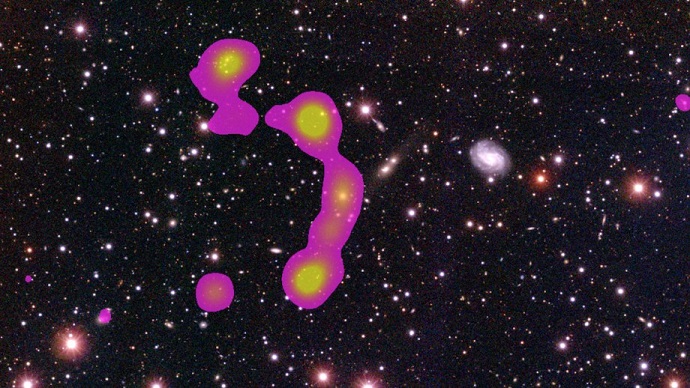15 JUNE 2016
Two volunteer astronomers have had a galaxy cluster named after them after finding the galaxy in an international citizen science project co-led by ANU.
The two Russians identified the huge C-shaped galaxy cluster from much smaller images of cosmic radio waves shown to them as part of the web-based Radio Galaxy Zoo program.
The discovery surprised the astronomers running the Radio Galaxy Zoo program, said project co-leader Dr Julie Banfield of the ARC Centre of Excellence for All-sky Astrophysics (CAASTRO) at the ANU.
"They found something that none of us had even thought would be possible," Dr Banfield said.
More than 10,000 volunteers have joined in with Radio Galaxy Zoo, classifying over 1.6 million images from NASA's Wide-Field Infrared Survey Explorer telescope and the NRAO Very Large Array in New Mexico in the United States.
"The dataset is just too big for any individual or small team to plough through - but we have already reached almost 60 per cent completeness," Dr Banfield said.
"Although radio astronomy is not as pretty as optical images from the Hubble space telescope, people can find cool things, like black holes, quasars, spiral galaxies or clusters of galaxies."
The project is led by Dr Banfield and Dr Ivy Wong from the International Centre for Radio Astronomy Research (ICRAR) at The University of Western Australia.
The astronomers classified the newly-discovered feature as a wide angle tail (WAT) radio galaxy, named for the C-shaped tail shape of highly energetic jets of plasma which are being ejected from it.
It will now be known as the Matorny-Terentev Cluster RGZ-CL J0823.2+0333, combining the names of the two volunteer scientists from Russia,Tsimafei Matorny and Ivan Terentev.
It is part of a previously unreported sparsely-populated galaxy cluster and one of the biggest ever found.
Their discovery has now been published in the Monthly Notices of the Royal Astronomical Society, with the two volunteers included as co-authors.
"This radio galaxy might have had two distinct episodes of activity during its lifetime, with quiet times of approximately one million years in between," said Radio Galaxy Zoo science team member and co-author Dr Anna Kapinska, also of CAASTRO/ICRAR at the University of Western Australia.













